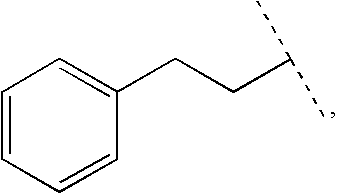Dicycloalkylcarbamoyl Ureas As Glucokinase Activators
a technology of glucokinase and dicycloalkylcarbamoyl urea, which is applied in the field ofdicycloalkylcarbamoyl ureas, can solve the problems of increasing the risk of diabetic complications, and increasing the risk of patients acquiring diabetes complications
- Summary
- Abstract
- Description
- Claims
- Application Information
AI Technical Summary
Problems solved by technology
Method used
Image
Examples
example 1
1,1-Bis-(cyclohexyl)-5-methyl biuret
[0251]
[0252]Prepared as described in General Procedure 1. To methyl urea (0.24 g) in tetrahydrofuran was added sodium hydride (22 mg of 60% in oil) and the reaction mixture stirred for 50 min at room temp. Dicyclohexyl carbamoyl chloride (0.8 g) was then added (ice bath cooling used during addition) and the mixture was stirred overnight. The reaction mixture was then added to 0.5 ml water, partially concentrated in vacuo and water (2 mL) and ethyl acetate (10 mL) was added. The non soluble material was removed by filtration and the organic layer collected and concentrated in vacuo. An aliquot of the crude was then dissolved in THF and purified by preparative LCMS to give the desired product (8 mg).
[0253]1H NMR (CDCl3): δ 1.10-1.90 (m, 20H), 2.33 (d, 3H), 3.22-3.40 (m, 2H), 6.65 (s, 1H), 8.45 (s, 1H).
[0254]HPLC-MS: m / z=282.1 (M+1)
example 2
1,1-Bis-(cyclohexyl)-5-butyl biuret
[0255]
[0256]Prepared as described in General Procedure 1 using dicyclohexyl carbamoyl chloride and butyl urea.
[0257]HPLC-MS (Method A): m / z=324.2 (M+1)
example 3
1,1-Bis-(cyclohexyl)-5-(3-pyridylmethyl) biuret
[0258]
[0259]Prepared as described in General Procedure 1 using dicyclohexyl carbamoyl chloride and 1-(3-pyridylmethyl)urea.
[0260]HPLC-MS (Method B): m / z=359.2 (M+1)
PUM
| Property | Measurement | Unit |
|---|---|---|
| Fraction | aaaaa | aaaaa |
| Time | aaaaa | aaaaa |
| Nanoscale particle size | aaaaa | aaaaa |
Abstract
Description
Claims
Application Information
 Login to View More
Login to View More - R&D
- Intellectual Property
- Life Sciences
- Materials
- Tech Scout
- Unparalleled Data Quality
- Higher Quality Content
- 60% Fewer Hallucinations
Browse by: Latest US Patents, China's latest patents, Technical Efficacy Thesaurus, Application Domain, Technology Topic, Popular Technical Reports.
© 2025 PatSnap. All rights reserved.Legal|Privacy policy|Modern Slavery Act Transparency Statement|Sitemap|About US| Contact US: help@patsnap.com



